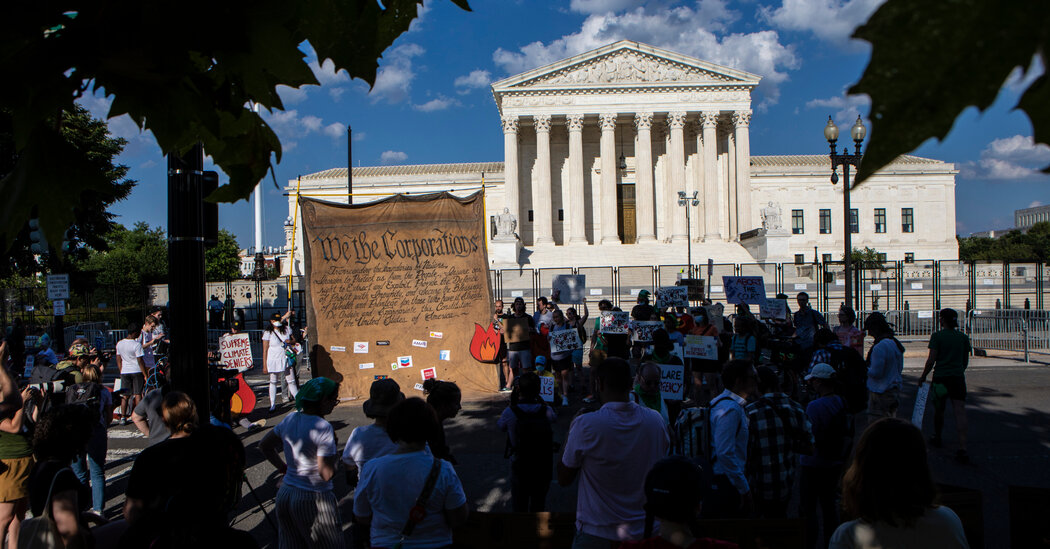Supreme Court’s E.P.A. Ruling Shifts More Power Away From Congress

[ad_1]
WASHINGTON — On the last day of a turbulent term that included rulings on what the Constitution has to say about abortion, guns and religion, the Supreme Court issued another sort of decision, one that turned on the words of the Clean Air Act.
Without “clear congressional authorization,” the court said, the Environmental Protection Agency was powerless to aggressively address climate change. In years past, that might have been the start of a dialogue with Congress, which after all has the last word on what statutes mean, because it can always pass new ones.
But thanks to legislative gridlock, Congress very seldom responds these days to Supreme Court decisions interpreting its statutes — and that means the balance of power between the branches has shifted, with the justices ascendant.
The consequences have been especially stark in Supreme Court rulings on global emergencies like climate change and the coronavirus pandemic, but the phenomenon is a general one. Congress has largely fallen silent as a partisan stalemate has gripped Capitol Hill, aggravated by the increased use of the filibuster, which has blocked almost all major legislation in an evenly divided Senate. The upshot is a more dominant court.
It was not always so.
“If you go back to the ’80s, every time the court did something Congress didn’t like, they passed a law,” said Richard J. Lazarus, a law professor at Harvard. “It was an iterative process between Congress, the agencies and the courts.”
Congressional inaction following Supreme Court rulings on statutes is not especially new, but it has taken on added importance as the court has veered to the right and is increasingly insisting on clear grants of congressional authority to executive agencies. In addition to the ruling on climate change, the court has recently declared that the Centers for Disease Control and Prevention was not authorized to impose a moratorium on evictions and that the Occupational Safety and Health Administration was not authorized to tell large employers to have their workers vaccinated against Covid-19 or undergo frequent testing.
Congress is, of course, powerless to revive a law that the Supreme Court has struck down as unconstitutional. In such cases, the court gets the last word, and only a constitutional amendment or a later overruling can undo its work.
The court’s decisions on campaign finance, including one in May, were based on the First Amendment and are examples of such constitutional rulings. The decision overturning Roe v. Wade, on the other hand, eliminated a constitutional right, allowing state and federal lawmakers to restrict or expand access to abortion.
But there are many other cases in which the court merely interprets statutes enacted by Congress. Its task in those cases is to determine what a law means, not to test its constitutionality. If Congress disagrees with the court’s interpretation, it is free to override the decision.
“In the ’70s and ’80s, Congress was passing major legislation all the time,” said Bruce Huber, a law professor at Notre Dame. “When something was wrong, there was a real colloquy between the court and Congress. The court would say, ‘Hey, this doesn’t stand up to scrutiny.’ And Congress would come back and say: ‘You’re right. We’ll fix it.’ And the very next session, you’d get a major amendment to the Clean Air Act or the Clean Water Act.”
In what the authors of a 2014 study called “the golden age of overrides,” Congress overrode 86 Supreme Court statutory decisions in the eight-year period starting in 1991. Since then, the study found, “there has been a very significant falloff.”
“Whatever power the court has to start with, which is considerable, it’s enhanced if Congress is unable to muster overrides,” said William N. Eskridge Jr., a law professor at Yale who conducted the study along with Matthew R. Christiansen, who is now general counsel of the Federal Energy Regulatory Commission.
Indeed, Professor Huber said, “with things as polarized as they are, the possibility of amending a statute has diminished to the vanishing point.”
The major environmental laws have not been amended in decades. The Clean Air Act, which was at issue in Thursday’s climate case, was last amended in 1990.
Since Congress will not act, Professor Lazarus said, “agencies like E.P.A. are relegated to working with increasingly old statutes to get their job done in addressing modern issues.”
That can make it difficult for an administrative agency to identify a clear grant of authority to address a problem not fully anticipated by the statute’s drafters. One approach in such circumstances is for courts to defer to the agency when the statutory text is ambiguous.
That approach, called Chevron deference, has long been under attack from conservatives, but it survived this past Supreme Court term.
Another approach is for courts to require a clear statement from Congress authorizing agencies to act where important political or economic issues are in play. That approach, called the major questions doctrine, served to hobble the E.P.A.’s power on Thursday.
The most prominent recent example of a congressional response to a Supreme Court ruling is 13 years old. It came after Ledbetter v. Goodyear Tire & Rubber Company, the 2007 ruling that said Title VII of the Civil Rights Act of 1964 imposed strict time limits for bringing workplace discrimination suits.
In her dissent, Justice Ruth Bader Ginsburg reminded lawmakers that on earlier occasions they had overridden what she called “a cramped interpretation of Title VII.”
“Once again,” she wrote, “the ball is in Congress’s court.”
Congress responded with the Lilly Ledbetter Fair Pay Act of 2009, which overrode the 2007 decision.
On Wednesday, Justice Neil M. Gorsuch cited the Ledbetter ruling in a dissent urging Congress to override a decision that he said had dealt a blow to the sovereignty of Native American tribes.
“Thanks to this court’s egregious misappropriation of legislative authority,” he wrote, quoting Justice Ginsburg, “‘the ball is back in Congress’s court.’”
He did not stop there, as Justice Brett M. Kavanaugh’s majority opinion noted. “The dissent goes so far as to draft a proposed statute for Congress,” Justice Kavanaugh wrote.
Understand the Supreme Court’s E.P.A. Ruling
A key decision. The Supreme Court issued a ruling limiting the Environmental Protection Agency’s ability to regulate carbon emissions from power plants, dealing a blow to the Biden administration’s efforts to address climate change. Here’s what to know:
But if recent practices are any guide, congressional action is unlikely.
Consider the Supreme Court’s 2013 decision in Shelby County v. Holder, which invited a congressional response that the justices must have known would not be forthcoming. The decision, which effectively gutted a key provision of the Voting Rights Act of 1965, did so indirectly, by striking down the law’s formula for determining which states and localities were covered by the law’s requirement that changes to voting procedures be cleared by federal authorities.
“Congress may draft another formula based on current conditions,” Chief Justice John G. Roberts Jr. wrote for the majority. Congress has not enacted a new formula.
Nor is there any likelihood that Congress will respond to the climate-change decision with the clear authorization the Supreme Court demanded.
“By insisting instead that an agency can promulgate an important and significant climate rule only by showing ‘clear congressional authorization’ at a time when the court knows that Congress is effectively dysfunctional,” Professor Lazarus said, “the court threatens to upend the national government’s ability to safeguard the public health and welfare.”
The Supreme Court has said it requires Congress to speak clearly in the interest of democratic accountability. In the climate decision, Chief Justice Roberts wrote that the people’s elected representatives should make decisions where the consequences are enormous.
“A decision of such magnitude and consequence rests with Congress itself, or an agency acting pursuant to a clear delegation from that representative body,” he wrote.
But the net effect of that approach was to enhance the Supreme Court’s own authority.
“They’re saying that they’re doing it for democracy purposes, but the fact is that they’re increasing their own power,” Professor Lazarus said.
Were democracy working, Professor Huber said, there would be new federal legislation to address the threat to the planet.
“If we had a Congress that at all reflected what the median American voter wanted,” he said, “we’d have relatively aggressive climate action.”
[ad_2]




